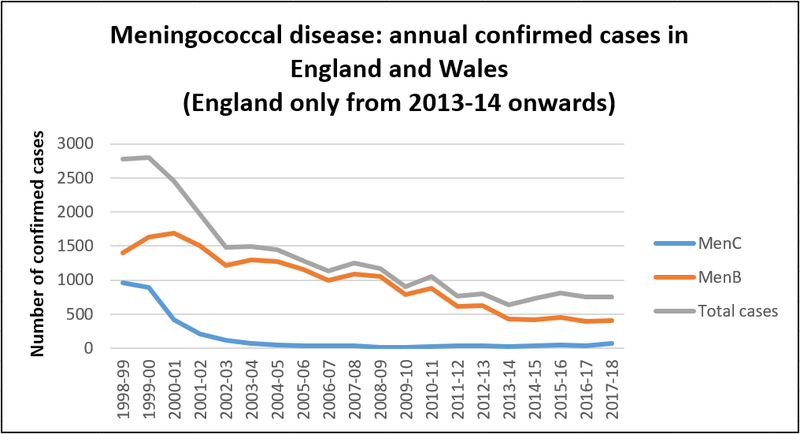|
Meningococcal disease is most often seen in infants and young children. However, there is a second peak in cases in 15-19 year olds, which is not seen in other infectious diseases. It is not known exactly what causes this. A major study, the UK Meningococcal Carriage Study 4  , is looking to see if there might be a connection with lifestyle factors such as smoking and kissing. , is looking to see if there might be a connection with lifestyle factors such as smoking and kissing.
Overall, numbers of cases of meningococcal disease have fallen in the UK in recent years. Following the introduction of the MenC vaccine in 1999, the number of cases caused by the type C disease fell by over 90% in vaccinated groups. It also fell by around 66% in non-vaccinated groups owing to herd immunity, as fewer people were carrying the bacteria in their throats and passing them to others (see graph below). Type C infections have caused only 2 deaths in children and young people under 20 in the last 5 years, compared to 78 deaths in the single year before the vaccine was introduced.
Following the success of the UK's MenC vaccination program, type B infections accounted for about 85% of the cases of meningococcal disease before the MenB vaccine was introduced. A total of around 750 people in the UK (mostly babies and children) were infected by MenB in 2011, and around 50 of these died. The MenB vaccine (introduced in September 2015) is expected to have an impact on numbers of cases of MenB disease. UK research from 2016  shows that the MenB vaccine should help to protect babies against other types of meningococcal infection, including the MenW strain which is on the increase in the UK. shows that the MenB vaccine should help to protect babies against other types of meningococcal infection, including the MenW strain which is on the increase in the UK.
At the moment disease cause by MenW is giving cause for concern in the UK. Cases in England increased from 30 cases in 2011-12 to 225 cases in 2016-17 (cases are counted from July one year to June the next year). There was a slight fall in cases in 2017-18 (193 cases). All cases are thought to be due to a single very aggressive strain of MenW bacteria. No other European country has reported an increase in MenW cases, and the reasons for the rise in UK cases is unknown. In response, the government decided to give the MenACWY vaccine to all teenagers and new university students. This programme started in summer 2015. See more information from Public Health England  and our blog post from March 2015. and our blog post from March 2015.
Oxford Vaccine Group (OVG) has worked on the development of MenB vaccines and run trials into their effectiveness. OVG has also run studies looking at the effectiveness of a vaccine which gives protection against strains A,C,W and Y.
The graph below shows the decline in meningococcal disease in the UK in the last 20 years:
|




